Portadown ~ Landing Place of the Ferry




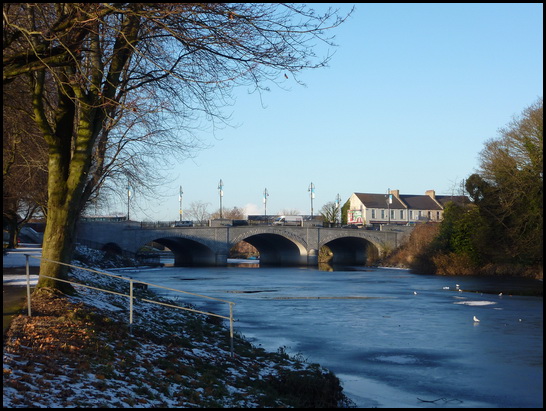
Portadown derives its name from the Irish 'Port an Dunain' which means 'landing place of the ferry'. The town has its beginnings in 1610 when James I granted 2,000 acres of land at Ballyworran (Ballyoran) to William Powell of Staffordshire. In 1611 Powell sold the land to the Reverend Richard Rolleston who then sold it to Richard Cope of Loughgall. Cope divided the land with Michael Obins who secured the land, which runs down to the west bank of the Bann.
By 1619 Obins had built a house of brick and lime along with a bawn or fortress and by 1622 had settled 30 scattered English families'. He died in 1629 and was succeeded by his son John who with his mother Prudence, secured a patent for fairs and markets in the town in 1632. Markets were then held every Saturday with a fair held on All Saints' Day and another at Pentecost, later another fair was held on Easter Monday. The opportunity for trade offered by these together with the building of the first bridge over the River Bann opened the way for commerce and prosperity in the town.
During the civil war in 1641 Portadown was pillaged by Captain Toole McCann under the command of Sir Phelim O'Neill. O'Neill was later tried and sentenced to death for the massacre of 196 settlers who drowned when thrown off the Bann bridge into the river below, those who didn't drown were killed as they reached the shore. Civil disturbances continued for several years until a garrison of Cromwellian soldiers arrived to take control of the town in October 1646.
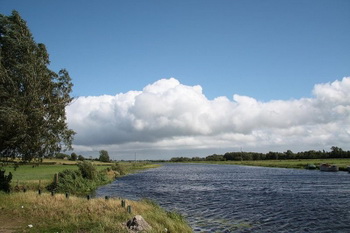 The manufacture of linen played a major part in the economic prosperity of Portadown. In 1762 Michael Obins petitioned the House of Commons in Dublin to establish a linen market. This market laid the foundation for Portadown's reputation as a major linen manufacturing and trade centre. Factories such as Watson Armstrong and Co, J & J Acheson and Co and Castleisland Linen Company provided employment for many local people in the weaving industry. The hemstitching industry in such factories as Hamilton Robb, Spence Bryson & Co, Moneypenny and Watson, Thomas Dawson, John Gilbert, Samuel Wilson and Andrew J Lutton & Son, increased greatly and provided further employment for the area. The manufacture of linen played a major part in the economic prosperity of Portadown. In 1762 Michael Obins petitioned the House of Commons in Dublin to establish a linen market. This market laid the foundation for Portadown's reputation as a major linen manufacturing and trade centre. Factories such as Watson Armstrong and Co, J & J Acheson and Co and Castleisland Linen Company provided employment for many local people in the weaving industry. The hemstitching industry in such factories as Hamilton Robb, Spence Bryson & Co, Moneypenny and Watson, Thomas Dawson, John Gilbert, Samuel Wilson and Andrew J Lutton & Son, increased greatly and provided further employment for the area.
When Portadown began to grow at the beginning of the nineteenth century, thirteen town-lands were separated from Drumcree, to form the parish of Portadown. The townlands are: Annagh Artabrackagh Ballyworkan Baltylum Clounagh Corcrain Drumnakelly Drumnasoo Garvaghy Kilmoriaty Mahon Mullantine Tavenagh The Curate of Drumcree, Robert Henry was appointed Curate in Charge.
Portadown especially made its name in the area of fine linen or Cambric and factories such as those of Hamilton Robb, Spence Bryson & Co and the Portadown Weaving Company flourished. At the top end of the linen trade was damask manufacture and again Portadown had its share of the market with goods produced by Castelisland Weaving Co, Achesons Ltd, Tavanagh Weaving Factory and Watson Armstrong.
In the 1830s the town of Portadown had a population of around one thousand and work other than weaving was centred on the town quay and shipping from the Canal and the Lough. The scene would have been a busy one with perhaps half a dozen lighters being loaded and unloaded along with a couple of barges or schooners. The cargoes would have consisted of grain, imported timber, iron, English and Scotch coal, slates, Irish coal, flour, and oatmeal. A small schooner from Scotland or Liverpool awaits a berth to unload slates, imported timber and potash. Salt also came in direct from England.
Lighters were used on the canal, while barges which were larger worked on the river and the lough as they were too wide for the canal. Barges really came into their own with the advent of steam when they were driven by engines. The scenes at the quay would have been noisy with carters shouting and belabouring their horses, while carts rattled over the rough stones on the road, some carting grain into the Distillery, others bringing in native timber and farm produce. It was to be another 50-60 years before the roads were tarmacadamed. A long line of carts waited at the quayside to collect the cargoes. Barley was collected for the distillery across the road. Up to 3000 tons of barley was used annually by the distillery. The distillery later became Calvin's Mill.
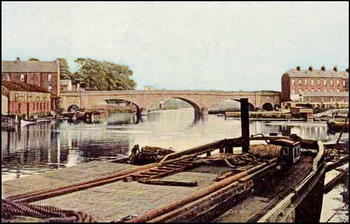 At Shillington's Quay two lighters unload, one with coal, the other building materials. Across the river can be seen a new barge being built in Bright's Boat Yard with the resultant sounds of hammering. Later this yard was to build iron barges for clients all around the Lough. Beside Shillington's Coal Yard another lighter is being winched up the repair shop slipway for repairs. Back at the town quay, a group of people await as the flyboat "The Grand Junction" sails in to discharge her passengers and pickup those awaiting, en route for Ballyronan and Newport trench, on the west shore of the Lough. Another one is seen coming up the river carrying passengers from Belturbet. Horse drawn omnibuses, brakes and side cars stand waiting to collect passengers from the flyboat, some for an Inn or Hostelry, others to await a stage coach for distant parts. The Quay is stacked with all sorts of cargo awaiting collection or loading onto lighter or barges. At Shillington's Quay two lighters unload, one with coal, the other building materials. Across the river can be seen a new barge being built in Bright's Boat Yard with the resultant sounds of hammering. Later this yard was to build iron barges for clients all around the Lough. Beside Shillington's Coal Yard another lighter is being winched up the repair shop slipway for repairs. Back at the town quay, a group of people await as the flyboat "The Grand Junction" sails in to discharge her passengers and pickup those awaiting, en route for Ballyronan and Newport trench, on the west shore of the Lough. Another one is seen coming up the river carrying passengers from Belturbet. Horse drawn omnibuses, brakes and side cars stand waiting to collect passengers from the flyboat, some for an Inn or Hostelry, others to await a stage coach for distant parts. The Quay is stacked with all sorts of cargo awaiting collection or loading onto lighter or barges.
The Schooner has finished off loading and is about to take on board her outward cargo .of barrels of apples, webs of linen and webs of bag cloth. Bag cloth was used for flour and other fine powder produce and was woven with less care than linen. A raft of timber arrives at Shillington's Quay from Newry, indeed it may have come from Liverpool. Timber was, and to a lesser extent still is, tied together in a large raft, the size of which depends on the depth of water it is to float in. Three feet seemed to be suitable for the canal. In the canal the raft was pulled by a horse and poled from the Point of Whitecoat. Passing upstream is a lighter laden with sand from Coalisland bound for Newry.
The river in winter annually overflows and from September to April the Bann Meadows become a lake. Lighters would have to rely on sail to get to the Point of Whitecoat as horses obviously could not have worked. No conclusive evidence exists proving that horses did pull lighters up the river to the Point of Whitecoat other than the fact that a causeway existed at the mouth of the Cusher River. Local anglers can remember fishing from it. Another man can remember diving from it as a boy when swimming. The Department of Agriculture Drainage Division demolished it in the early sixties to improve the flow - it would have been lying disused from the introduction of the steam tug in the eighteen twenties.
The first steam boat to sail on Lough Neagh was the "Marchioness of Donegall" in 1821, a paddle steamer. She sailed, or rather worked out of Ellis's Cut but her operation proved expensive to run and she was laid up circa 1845. The first steam boats to sail out of Portadown were the "Grand Junction" and the "Countess of Caledon". They were flyboats operating services from Portadown to and from Ballyronan on the west shore of the Lough and to Enniskillen and Belturbet. They were scrapped in 1851, presumably because the trains outmoded them.
By the eighteen eighties there were six quays and two slipways in the town, with a further five smaller ones between Robbs ferry, Derrybroughas, and Moyallon. Some were small private quays like the one at Carrickblacker House, which had its own small canal from the river Bann to a landing stage at the bottom of the slope leading to the big house. It was used for deliveries of coal and turf.
In 1888 George Henry Bassett wrote his History of Portadown in which he writes:
Portadown is pleasantly situated on the Bann, 87 and one quarter miles north by west from Dublin, 25 miles south by west from Belfast, 10 and a half miles north-east from Armagh, and 5 miles south-west from Lurgan. Estimated population, 10,000 in 1888. It is an important junction in the system of the Great Northern Railway, embracing the counties of Armagh, Antrim, Down, Monaghan and Tyrone, and at the chief port on the canal between Newry and Lough Neagh. The ground rises high enough at both sides of the river to afford a great many beautiful sites for villas, and the wealthy residents, in recent years, have taken advantage of them to such an extent, as to greatly enrich the picturesque features of the outskirts.
From the manufacturing point of view Portadown comes next to Lurgan. In its weaving and hem-stitching factories, and spinning mills, employment is given to over 3,000 people, and it is the centre of a district in which there are upward of 2,500 cottage-weavers. As a market for general produce it ranks with the foremost towns in the North of Ireland. The great market is held every Saturday, and although several inclosed places are specially provided for conducting transactions incident to sale and purchase, there is an overflow of odds-and-ends that has a fascination for the country people, the effect of which is quite amusing. A prominent figure in the overflow is the vendor of second-hand clothing. In style, manner and get-up he is intensely dramatic, and with every article offered, goes through a form sustained by speech and gesture to a most artistic climax. Travelling shooting-galleries, shows on wheels, dancing maidens, and venerable acrobats, in a modest way, second the efforts of the clothing artist. The warehouse windows, and the side-walks in front, on such occasions are dressed in bright colours. Indeed, nothing seems to be left undone in order to make the day one of genuine pleasure as well as of business.
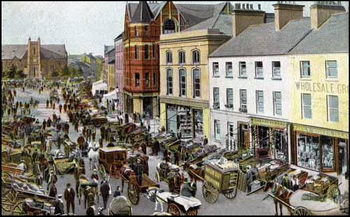 The residents of Portadown have considerable taste. This fact soon becomes manifest to the stranger in going through the streets. Most of the building are well constructed and sightly, and the places of worship, in architectural outlines and internal decoration, are very much above the average. Societies for mental and physical culture exist in proportion to the requirements of the population, and there is a public park, purchased and laid out by subscription, in which the people are familiarized with the beauties of nature. The residents of Portadown have considerable taste. This fact soon becomes manifest to the stranger in going through the streets. Most of the building are well constructed and sightly, and the places of worship, in architectural outlines and internal decoration, are very much above the average. Societies for mental and physical culture exist in proportion to the requirements of the population, and there is a public park, purchased and laid out by subscription, in which the people are familiarized with the beauties of nature.
In every direction from Portadown the formation of the country is favourable to agricultural operation. The land is generally good. Potatoes, oats and flax are the principal crops. Dairying is not carried on as largely as it was ten years ago, but it still receives attention. A great many of the farmers find fruit-growing a valuable aid to income. Apple-orchards are abundant, especially toward the west, facing Loughgall. In the season it is not uncommon to find 200 loads of apples on one Saturday in Portadown.
Before the power of England became supreme in the County Armagh, the district of Portadown was in possession of the McCanns. They were subordinate to the O'Neills and had a stronghold which commanded the passage of the Bann, and gave name to the place, Port-ne-dun, port of the dun or fortress. In those days the wealth of chieftains was measured by the number of cattle in their herds. Payments of consequence, such as tribute to the kings, ransomes, etc., were made in cattle. Cattle were also used as a means of barter. The country of the M'Canns was well adapted for grazing purposes, and no doubt was largely used in this way. At the time of the Plantation of Ulster, 1609, James 1, granted an extensive "portion" of land here to William Powell. In 1625 this was confirmed to Prudence Obins and John Obins. They formed a settlement with 14 English families, and built a fine mansion in the Elizabethan style, with turreted corners. It was called a castle and its chief approach was by way of the thoroughfare now known as Castle Street. The People's Park was a part of the demesne, and the nursery of Messrs. Samuel McGredy & Son, Woodside, was the site of at least a portion of the mansion. A few years ago, during the progress of an excavation in the grounds devoted to rose cultivation, a vaulted passage was discovered. It runs into the People's Park, and is 6 feet high and 4 feet wide. A few green oaks mark the parts known as the Castle Gardens. One at the gate entering the Park, a short distance below the nursery, is in a wonderful state of preservation, and really worth seeing, especially by those interested in arboriculture. The Yeomanry Barrack stood at the opposite side of the road from the nursery, now the residence of Mr.Seth Robb.
During the war of 1641, directed by the Confederate Parliament at Kilkenny, terrible scenes were enacted at Portadown Bridge. Captives taken by Sir Phelim O'Neill were brought from various parts of the country, and drowned in the river, those escaping the water being killed as they reached the shore. After Col. Owen Roe O'Neill had assumed command of the "Catholic Army of the North," he took prompt measures to put a stop to the horrors which had been sanctioned by his predecessor. Imprisoned families were released, and the strife conducted more in accordance with ideas of chivalry. At the trial of Sir Phelim in Dublin, 1652, a supernatural element was introduced. One of the witnesses, wife of Captain Price, testified that she was present at Portadown Bridge, when the form of a woman rose out of the water, and cried, "Revenge, revenge, revenge". Col. Owen Roe O'Neill was also here, and by his directions a Catholic priest questioned the apparation in English and Latin without eliciting a reply. A Protestant clergyman from the English army, specially sent for, addressed it on another occasion, and the words, "Revenge, revenge, revenge", were repeated. It was said that for some time the heads and forms of men and women were frequently seen at the same place. The trial ended ing the conviction of Sir Phelim O'Neill, and he was put to death.
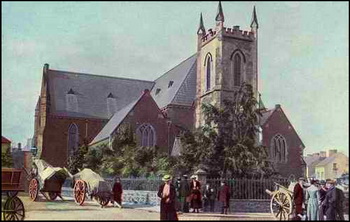 Portadown is owned by the Duke of Manchester. From the time of the Obins settlement progress was slow until the introduction of the linen industry at the beginning of the century. In 1819 the population numbered 900. In 1831 it had increased to 1,591 and in 1881 to 7,850 At present it cannot be far from 10,000. Portadown is a district parish, and was confined to the barony of O'Neilland West, on the western side of the Bann, until 1840. Its boundary was then extended to the parish of Seagoe. The principal thoroughfare of the town is united to Edenderry by a fine stone bridge. A few of the factories, the gas works, railway station, and many of the handsome private residences are on the same side. Portadown is owned by the Duke of Manchester. From the time of the Obins settlement progress was slow until the introduction of the linen industry at the beginning of the century. In 1819 the population numbered 900. In 1831 it had increased to 1,591 and in 1881 to 7,850 At present it cannot be far from 10,000. Portadown is a district parish, and was confined to the barony of O'Neilland West, on the western side of the Bann, until 1840. Its boundary was then extended to the parish of Seagoe. The principal thoroughfare of the town is united to Edenderry by a fine stone bridge. A few of the factories, the gas works, railway station, and many of the handsome private residences are on the same side.
Soon after the passing of the Act to provide for the lighting, cleansing, and watching of town, 1829, Portadown took advantage of it. The inhabitants lost no time in petitioning the Lord Lieutenant to be brought within the scope of the Towns Improvement Act of 1854. On the 8th January, 1885, the Commissioners elected under it held their first meeting. They were : John Obins Woodhouse, chairman, Thomas Averell Shillington, William Langtry, William Paul, Thomas Harden Carlton, John Wilson, David Thornton, David Wilson Irwin, John Watson, John James Marley, James O'Hanlon, William Montgomery, David Ferguson, and William John Dawson.
Of the entire number three only survive ; Messrs. James O'Hanlon, David Thornton, and William Montgomery. No change has been made in the town boundary since 1840. It includes the whole townland of Tavanagh, Corcrain, from Tavanagh and Clounagh to Pound Lane, thence to a point next to Corcrain Bridge, to the Dungannon Road, the Ballybay River, to the drain passing under Castle Island Bridge, continuing by the drain across the Bann, taking in Edenderry to the Lurgan Road, "and by the ditch outside Mr. Carlton's garden to the bogs, and from the end of said ditch, in a straight line, to the River Bann, at the point where the mearing between Edenderry and Levaghery meets at the river."
This year, 1888 the Local Government Board has been asked to sanction a further extension of the boundary from "Lurgan Road to Seagoe Turns, and from Quarry's Turns to end of Quarry's property on Killicomain Road, and from Annagh Bridge, on Tandragee Road, to south end of James Totten's property on same road". This would bring in that portion of the townland of Edenderry not included in the boundary of 1840, and the whole townland of Annagh. The object is to get jurisdiction over a district in which new villas and other dwellings have been erected, so that the occupiers, by contributing to the taxes levied by the Commissioners, may share in the benefits of public lighting, cleansing and sewerage.
The town was brought under the provisions of the Sanitary Act of 1874, and continued under the Amended Act of 1878. In 1857 the valuation of property within the boundary was £5,210.10s. and the rate for general purposes 1s. in the £. In 1862 the valuation was £7,066.5s. and the general purposes rate 1s.
The progress of the town between 1862 and 1870 is marked by an increase in the valuation to £14,163.15s., more than double, while the rate for general purposes continued the same. In 1876 the valuation was £15,162.5s., and the rate for general purposes that year was only 11d. in the £. The valuation in 1886 was £17,510.15s., and the rate for general purposes 1s. In 1887 the valuation was £17,679.10s., and the rate for general purposes is 1s.
Our thanks to George Robinson and George Henry Bassett.


|

